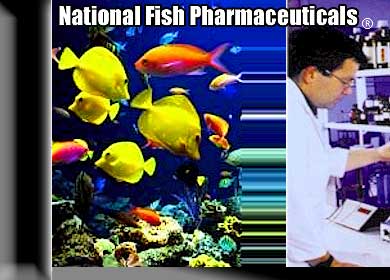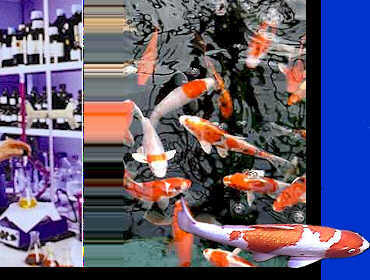FISH DISEASE ARTICLES: HETEROPOLARIA
Here is a very interesting article for all Koi hobbyists and
professionals. Everyone who has ever dealt with Aeromonas
(hole in the side disease) should read this article.
Heteropolaria affects the body, fins and gills of the fish.
This disease is often associated with Aeromonas and Pseudomonas. Epistylis can be the cause for these two, and many other diseases.
This disease is common in waters containing high organic matter,
i.e. ponds and lakes. It is prevalent during winter months,
but outbreaks of red sore disease are more commonly seen in spring
and summer months.
Heavy infections of Heteropolaria are characterized by white-gray
cottonlike patches on the body surface. Ulcers may develop,
and the fish may roll on their sides and start "flashing" like they
have parasites. Red sore disease is also characterized by
scale erosion, lesions on the body surface and bacterial hemorrhagic
septicemia. The infectious diseases are actually caused by the
attachment of this protozoan. See Fig. 1.1 below.
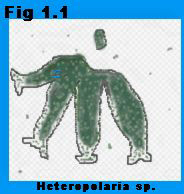 |
Heteropolaria uses the fish as substrate for attachment
only, and feeds on bacteria and organic debris from the
surrounding water. The attachment of this protozoan
imbeds itself in the epidermis of the skin, therefore creating
an opening for a secondary bacterial and/or fungal disease to
enter (i.e. hemorrhagic septicemia, aeromonas, saprolegnia
fungus). This protozoan may also be a secondary invader of
bacterial lesions. Heteropolaria may also cause severe
irritation or suffocation, and the efforts of the fish to remove
them may cause bruising or open wounds on the skin (from
flashing). |
So basically, this protozoan may be the cause of secondary
infections in your fish and must be dealt with accordingly.
Water quality is always the key, and infections like this may be
prevented by maintaining good water quality. Heteropolaria may
be treated by using
Formaldehyde or Forma-Green in the pond. Metronidazole
or Quinine Sulfate may also be used to combat this protozoan
infection if you isolate the fish and treat him in a hospital tank.
If you use a nitrifying bacteria, like our Aqua Gold to maintain
your water quality, heteropolaria and many other diseases may be
avoided. Earlier in this article we discussed the fact that
heteropolaria is present in waters containing high amounts of
organic matter. Koi ponds contain enough organic matter to
create a bacterial, fungal and protozoan "Factory" in most cases
when not properly maintained. This is why many people are
"constantly" treating their pond month after month and never have
any success with their fish. The dirtier the pond, the larger
breeding ground for disease is developed. We know that summer
months are especially difficult due to algal blooms and soaring
temperatures. Try to have some shade for your pond by planting
some non-disciduous trees around it, or using a cover (many types of
covers available through your local nursery). Make sure
you use plenty, even double or triple the amount of nitrifying
bacteria in your pond during the summer months. Also use an
algal inhibitor like Crystal Blue if you have problem green water.
Also make sure your filtration is in accordance with the load of
fish that you have in the pond. Overfeeding is another cause
of undue organic matter. You don't need to feed your fish 3
times a day. Once a day is just fine. Feed enough food
so that they can clean it up in about 5 minutes. More
than that is considered over-feeding.
Now, most importantly, we discussed the fact that heteropolaria
can cause an opening for a secondary bacterial or fungal infection
to happen right? O.K. so you have ulcerations on the
fish. I suggest first that you try something like
Oxytetracycline Hydrochloride in the feed. Use 2 teaspoons
mixed in approximately 2oz. of water. Mix well. Add the
medication to a spray bottle and spray it over 1 pound of koi
pellets. Let air dry (not in the sun, oven or with hair
dryer), use a fan to expedite the drying process if necessary. Once
the food is completely dry, feed this to the fish once a day, for up
to 14 days. This treatment is for hemorrhagic septicemia which
Koi are very susceptible to. If the Oxytetracycline produces
no results, you may have Pseudomonas. If this is the case, use
Neomycin or Kanamycin Sulfate Powder at the same directions and treatment method
explained above. With both diseases, isolate the fish if
possible and use Forma-Green in the water to help prevent
a secondary fungal infection like Saproglenia from developing.
A temperature bump also speeds up the
healing process. Bump it up to 75-80°F if possible.
We have cured fish with these diseases in two weeks using these
methods.
If you do have fish
with sores and are not sure which bacteria you are dealing with, it
is suggested to use our Koi Fix®
product which will kill both Aeromonas and Pseudomonas bacteria
►
Best Regards,
Dr. Gary Aukes; Pharm D, Dr. Brian Aukes; PhD., and the staff of National Fish
Pharmaceuticals.
|

Fish Disease Articles
|
Items that can be used to treat the diseases listed
in this article include: Forma-Green
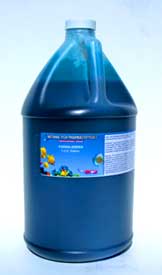
Koi Fix For Food
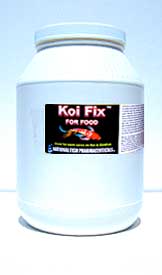
For optimum results, use along with the Forma-Green
|
|
